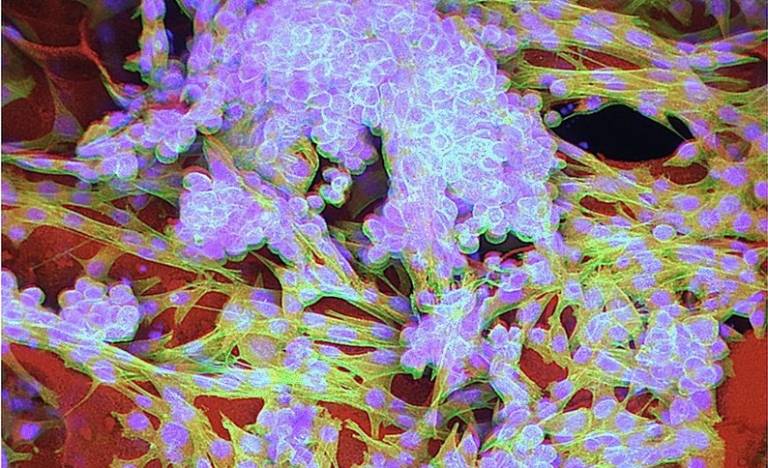Computer model reveals how early-stage skin cancer can stay ‘invisible’ to immune cells
16 May 2023
New research by UCL scientists has shown how melanomas can grow undetected by the body’s immune system, with findings offering a way to identify novel drug combinations to treat the disease.

In the study, published in Science Advances, researchers developed a computer model to identify the local crosstalk between melanoma cells and skin-specific immune cells known as Langerhans cells (LCs). The model predicted that the LCs were not activated by melanomas until tumours were large enough to trigger a response, determined by the presence of high levels of a cell signaling chemical called Tumour Necrosis Factor alpha (TNF-α).
Sentinels of the skin
Within the skin, Langerhans Cells (LCs) play a vital role in immune surveillance by alerting the immune system to the presence of pathogens and other foreign materials. As LCs form a network across the outer layers of the skin, they are predicted to be the first immune cells capable of detecting the earliest stages of melanoma. However, growing melanomas appear to be ignored, or they escape recognition, by LCs. The study team wanted to find out more about what is happening between these cells.
“We were looking for the molecular mechanisms behind the interaction between these two types of cells - the melanoma and immune cells. We wanted to ask specific questions about the dialogue between these cells and build a computational model that can then address those questions.” says Jasmin Fisher, Professor of Computational Biology and UCL and co-lead author of the study.
Professor Fisher and her team at UCL specialise in executable cancer models. This approach uses the vast amounts of available data on cell biology to develop computer programmes that mimic how cancer cells behave. Bespoke computational models are developed for different types of cancers. Crucially, these executable models are not backbox machine-learning; every process is mapped out from initial input to final output. Predictions made by the models can then be verified by lab experimental testing.
“Our computational model predicted that LCs cannot detect melanoma until a tumour becomes large enough to produce high levels of the TNF-α chemical. Increased TNF-α triggers the LCs to migrate to lymph nodes to activate an immune response. However, patient data suggest that at this point it is too late for the LCs to function properly. These predictions are in line with what we observed using research models in the lab,” says Professor Fisher.
In silico drug screening
In addition, the researchers used the melanoma computational model to test current treatments and look for new combinations of drugs. The model showed that treatment of primary tumours with drugs that block the growth of cancer (such as dabrafenib and trametinib) may also negatively affect the function of LCs, and that patients may benefit from a combination of targeted drugs that could prevent tumour growth, without further impairing LCs' ability to recognise cancer.
“Surgical removal of early-stage melanomas from the skin is very successful. The problems arise when the tumour has grown a little deeper into the skin, the melanoma then may have the ability to spread and if that happens it's much harder to treat. So, we approached this by saying if we can understand more about why melanomas can grow undetected by the skin, then might we be able to prevent the disease reaching a more serious stage,” explains Dr Clare Bennett, Associate Professor in Immuno-haematology at UCL and co-lead author of the study.
"Currently, the focus is on targeted drugs that stop the melanoma from growing and we don't always think about what that might be doing to the immune response. Our model indicated that some of these drugs could be detrimental to LCs i.e., preventing them from telling T cells that something is wrong. So it may be that we need to modify the way that we use these drugs. Or - as our model suggested - deploy different combinations of drugs that are effective against the melanoma but at the same time preserve the function of LCs."
“Going forward, we may be able find a way halting the melanoma before it gets a chance to grow and escape to other parts of the body. That would be hugely exciting."
Further information
- Research paper: Localized immune surveillance of primary melanoma in the skin deciphered through executable modeling. Science Advances
- UCL Cancer Institute
- Jasmin Fisher Academic profile
- Clare Bennett academic profile
- UCL Fisher Lab - Computational Cancer Biology
- UCL Bennett Lab - Dentritic Cell Immunotherapy
- Main image: NIH Flickr Credit: Sidi A. Bencherif, Thomas Ferrante / Wyss Institute at Harvard University
 Close
Close

